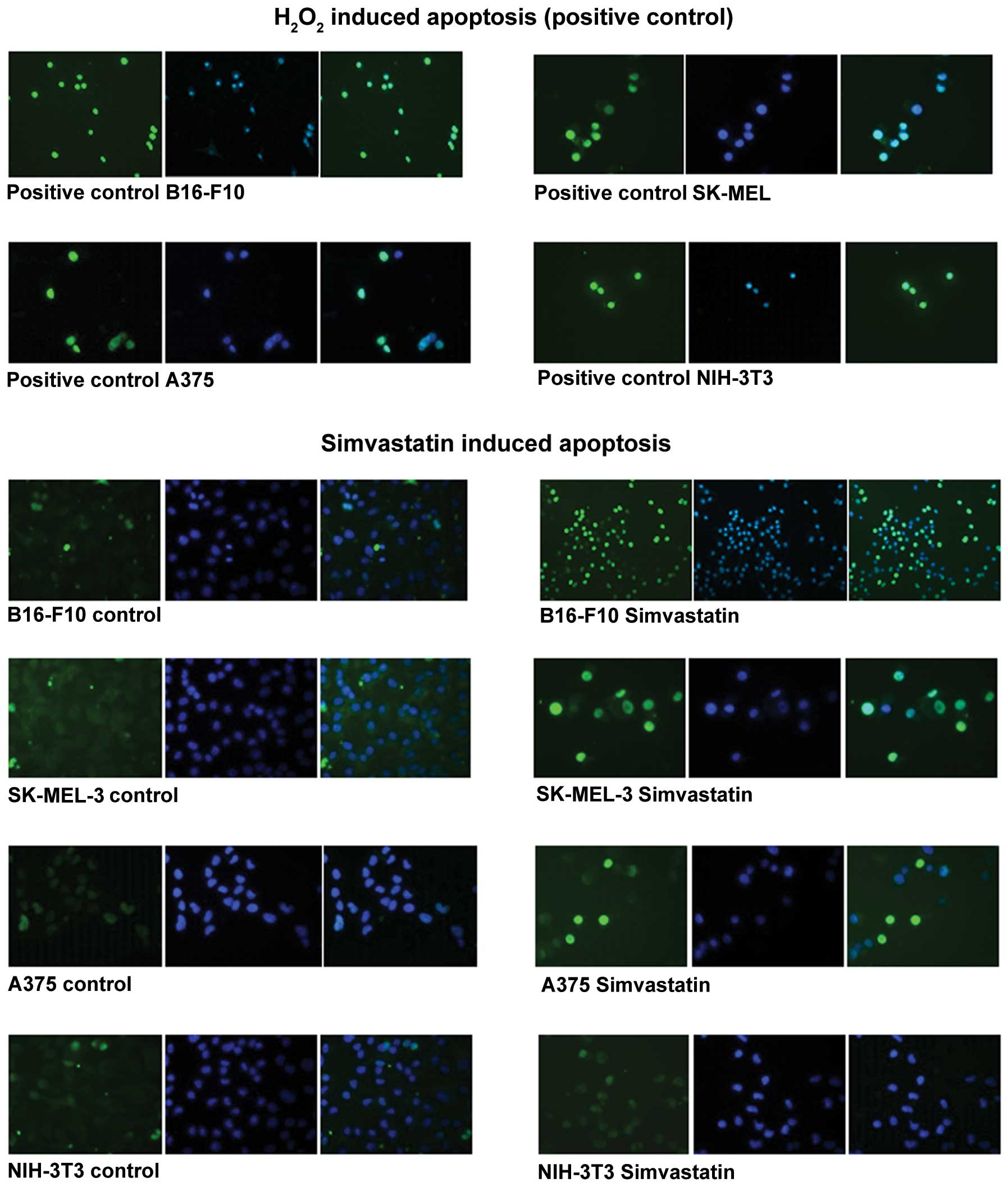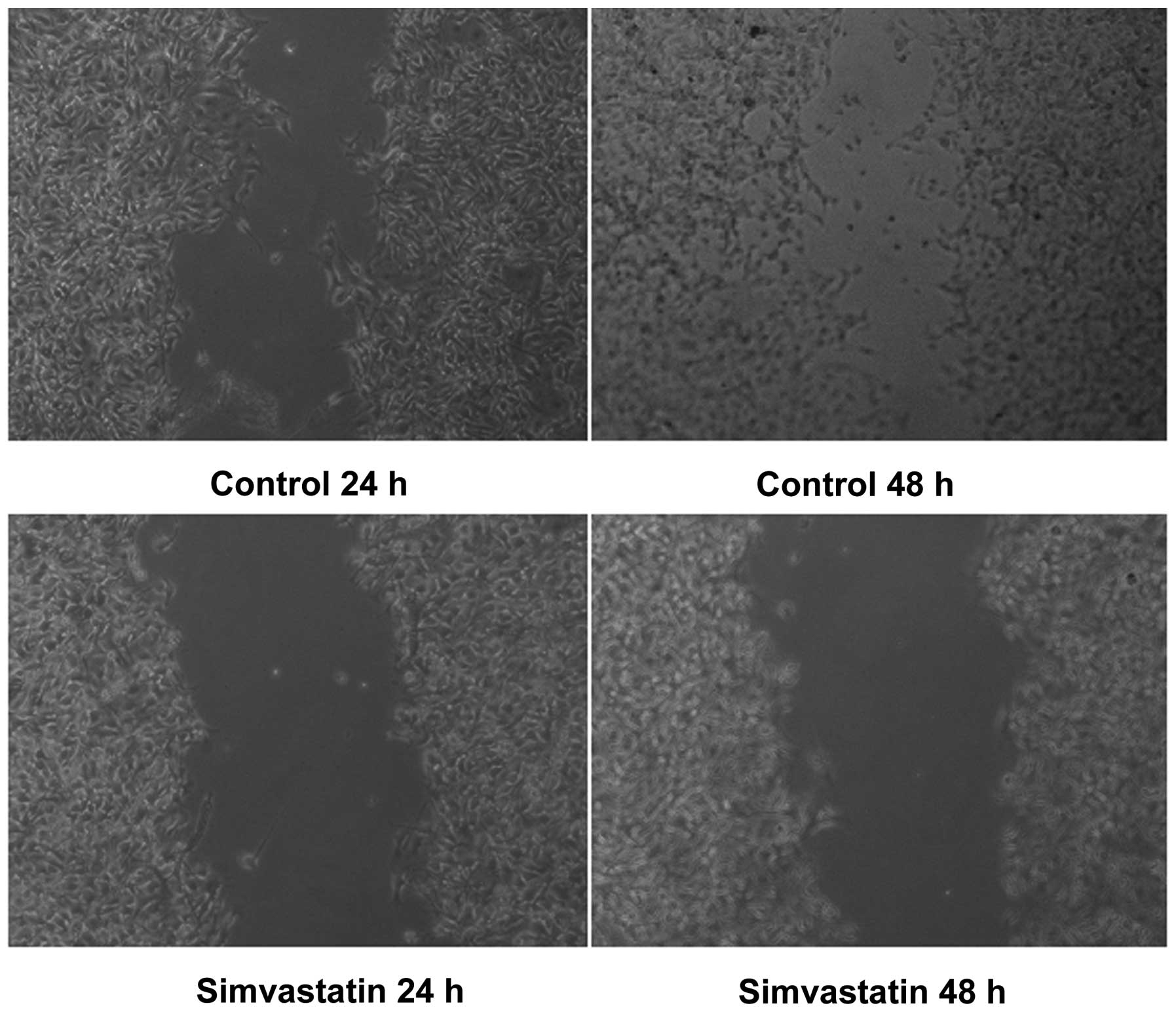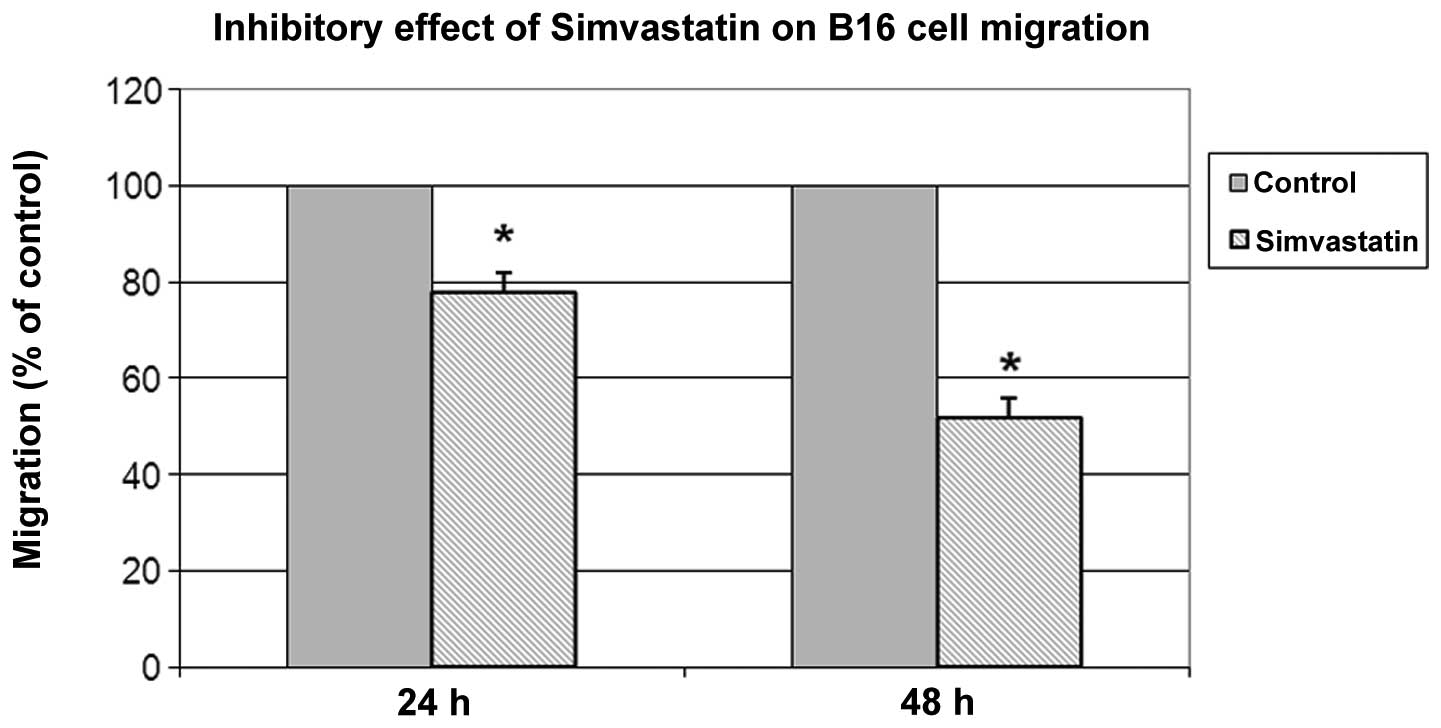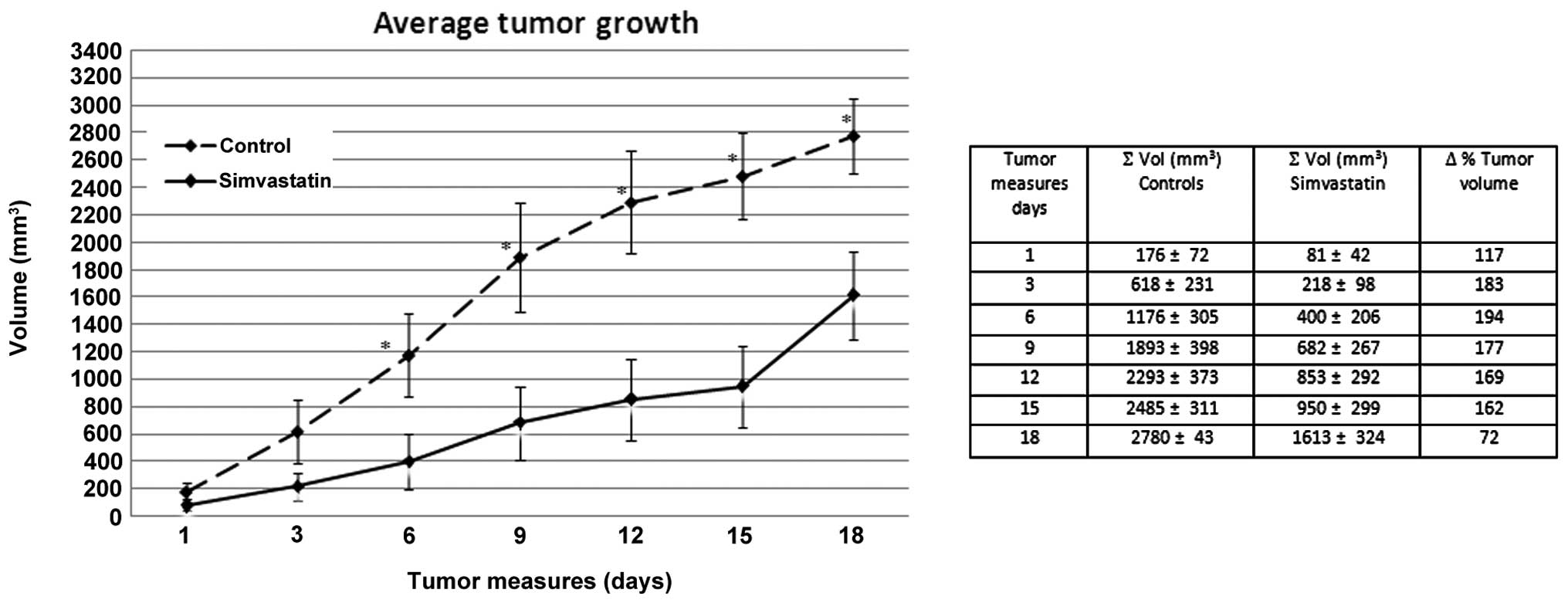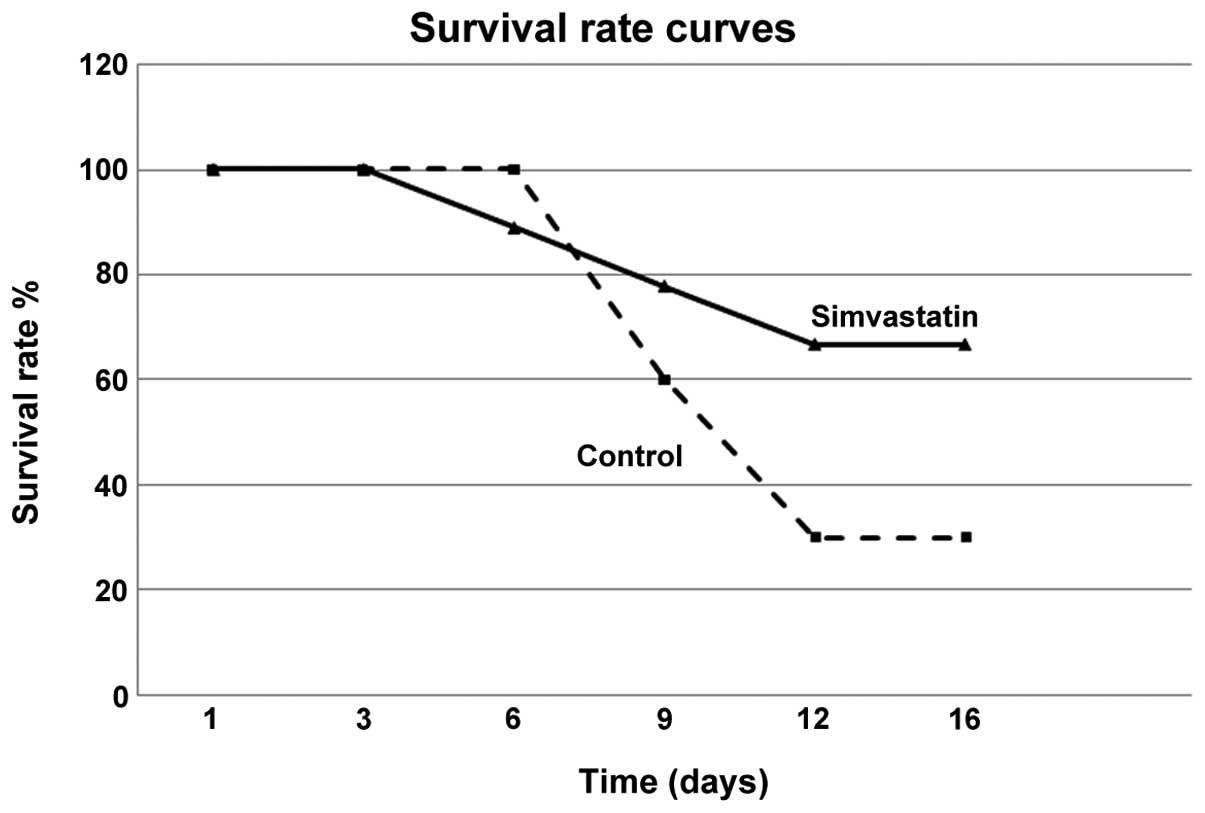|
1.
|
Spampanato C, De Maria S, Sarnataro M,
Giordano E, Zanfardino M, Baiano S, Cartenì M and Morelli F:
Simvastatin inhibit cancer cell growth inducing apoptosis
correlated to activation of Bax and downregulation of BCL2 gene
expression. Int J Oncol. 40:935–941. 2012.PubMed/NCBI
|
|
2.
|
Gauthaman K, Fong CY and Bongso A:
Statins, stem cells, and cancer. J Cell Biochem. 106:975–983. 2009.
View Article : Google Scholar : PubMed/NCBI
|
|
3.
|
Goldstein JL and Brown MS: Regulation of
the mevalonate pathway. Nature. 343:425–430. 1990. View Article : Google Scholar : PubMed/NCBI
|
|
4.
|
Liao JK and Laufs U: Pleiotropic effects
of statins. Annu Rev Pharmacol Toxicol. 45:89–118. 2005. View Article : Google Scholar : PubMed/NCBI
|
|
5.
|
Lee MH, Yee Cho S and Han YM: Simvastatin
suppresses self-renewal of mouse embryonic stem cells by inhibiting
RhoA geranylgeranylation. Stem Cell. 25:1654–1663. 2007. View Article : Google Scholar : PubMed/NCBI
|
|
6.
|
Chan KK, Oza AM and Siu LL: The statins as
anticancer agents. Clin Cancer Res. 9:10–19. 2003.
|
|
7.
|
Demierre MF, Higgins PD, Gruber SB, Hawk E
and Lippman SM: Statins and cancer prevention. Nat Rev Cancer.
5:930–942. 2005. View
Article : Google Scholar : PubMed/NCBI
|
|
8.
|
Mantha AJ, Hanson JE, Goss G, Lagarde AE,
Lorimer IA and Dimitroulakos J: Targeting the mevalonate pathway
inhibits the function of the epidermal growth factor receptor. Clin
Cancer Res. 11:2398–2407. 2005. View Article : Google Scholar : PubMed/NCBI
|
|
9.
|
Wong WW, Dimitroulakos J, Minden MD and
Penn LZ: HMBCoA reductase inhibitors and the malignant cell: the
statin family of drugs as triggers of tumor-specific apoptosis.
Leukemia. 16:508–519. 2002. View Article : Google Scholar : PubMed/NCBI
|
|
10.
|
Wu J, Wong WW, Khosravi F, Minden MD and
Penn LZ: Blocking the Raf-MEK-ERK pathway sensitizes acute
myelogenous leukemia cells to lovastatin-induced apoptosis. Cancer
Res. 64:6461–6468. 2004. View Article : Google Scholar : PubMed/NCBI
|
|
11.
|
Cafforio P, Dammacco F, Gernone A and
Silvestris F: Statins activate the mitochondrial pathway of
apoptosis in human lymphoblasts and myeloma cells. Carcinogenesis.
26:883–891. 2005. View Article : Google Scholar : PubMed/NCBI
|
|
12.
|
Mady EA: Association between estradiol,
estrogen receptors, total lipids, triglycerides, and cholesterol in
patients with benign and malignant breast tumors. J Steroid Biochem
Mol Biol. 75:323–328. 2000. View Article : Google Scholar : PubMed/NCBI
|
|
13.
|
Nygren C, von Holst H, Mansson JE and
Fredman P: Increased levels of cholesterol esters in glioma tissue
and surrounding areas of human brain. Br J Neurosurg. 11:216–220.
1997. View Article : Google Scholar : PubMed/NCBI
|
|
14.
|
Peterson C, Vitols S, Rudling M, Blomgren
H, Edsmyr F and Skoog L: Hypocholesterolemia in cancer patients may
be caused by elevated LDL receptor activities in malignant cells.
Med Oncol Tumor Pharmacother. 2:143–147. 1985.PubMed/NCBI
|
|
15.
|
Kokoglu E, Gorseval A, Sonmez H and Ozyurt
E: Tissue lipid composition of human gliomas and meningiomas.
Cancer Lett. 65:169–171. 1992. View Article : Google Scholar : PubMed/NCBI
|
|
16.
|
Poynter JN, Gruber SB, Higgins PD, Almog
R, Bonner JD, et al: Statins and the risk of colorectal cancer. N
Engl J Med. 352:2184–2192. 2005. View Article : Google Scholar : PubMed/NCBI
|
|
17.
|
Shannon J, Tewoderos S, Garzotto M, Beer
TM, et al: Statins and prostate cancer risk: a case-control study.
Am J Epidemiol. 162:318–325. 2005. View Article : Google Scholar : PubMed/NCBI
|
|
18.
|
Fowke JH, Motley SS, Barocas DA, Cookson
MS, Concepcion R, Byerly S, et al: The associations between statin
use and prostate cancer screening, prostate size, high-grade
prostatic intraepithelial neoplasia (PIN), and prostate cancer.
Cancer Causes Control. 22:417–426. 2011. View Article : Google Scholar
|
|
19.
|
Kim K: Statin and cancer risks: from
tasseomancy of epidemiologic studies to meta-analyses. J Clin
Oncol. 24:4796–4797. 2006. View Article : Google Scholar : PubMed/NCBI
|
|
20.
|
Dale KM, Coleman CI, Henyan NN, Kluger J
and White CM: Statins and cancer risk: a meta-analysis. JAMA.
295:74–80. 2006. View Article : Google Scholar : PubMed/NCBI
|
|
21.
|
Jacobs EJ, Rodriguez C, Brady KA, Connell
CJ, Thun MJ, et al: Cholesterol-lowering drugs and colorectal
cancer incidence in a large United States cohort. J Natl Cancer
Inst. 98:69–72. 2006. View Article : Google Scholar : PubMed/NCBI
|
|
22.
|
Chang CC, Ho SC, Chiu HF and Yang CY:
Statins increase the risk of prostate cancer: A population-based
case-control study. Prostate. 71:1818–1824. 2011. View Article : Google Scholar : PubMed/NCBI
|
|
23.
|
Menter DG, Ramsauer VP, Harirforoosh S,
Chakraborty K, Yang P, et al: Differential effects of pravastatin
and simvastatin on the growth of tumor cells from different organ
sites. PLoS One. 6:e288132011. View Article : Google Scholar : PubMed/NCBI
|
|
24.
|
Lee SK, Kim YC, Song SB, Young BS and Kim
S: Stabilization and translocation of p53 to mitochondria is linked
to Bax translocation to mitochondria in simvastatin-induced
apoptosis. Biochem Biophys Res Commun. 391:1592–1597. 2010.
View Article : Google Scholar : PubMed/NCBI
|
|
25.
|
Blanco-Colio LM, Villa A, Ortego M,
Hernandez-Presa MA, Pascual A, et al: 3-Hydroxy-3-methyl-glutaryl
coenzyme A reductase inhibitors, atorvastatin and simvastatin,
induce apoptosis of vascular smooth muscle cells by down-regulation
of Bcl-2 expression and Rho A prenylation. Atherosclerosis.
161:17–26. 2002. View Article : Google Scholar
|
|
26.
|
Herrero-Martin G and Lopez-Rivas A:
Statins activate a mitochondrial-operated pathway of apoptosis in
breast tumor cells by a mechanism regulated by Erb B2 and dependent
on the prenylation of proteins. FEBS Lett. 582:2589–2594. 2008.
View Article : Google Scholar : PubMed/NCBI
|
|
27.
|
Vousden KH and Lu X: Live or let die: the
cell’s response to p53. Nat Rev Cancer. 2:594–604. 2002.
|
|
28.
|
Chipuk JE and Green DR: Dissecting
p53-dependent apoptosis. Cell Death Differ. 13:994–1002. 2006.
View Article : Google Scholar : PubMed/NCBI
|
|
29.
|
Stier S, Totzk G, Grünewald E, et al:
Identification of p54nrband the 14-3-3 protein HS1 as
TNF-α-inducible genes related to cell cycle control and apoptosis
in human arterial endothelial cells. J Biochem Mol Biol.
38:447–456. 2005.
|
|
30.
|
Dong B, Horowitz DS, Kobayashi R and
Krainer AR: Purification and cDNA cloning of HeLa cell
p54nrb, a nuclear protein with two RNA recognition
motifs and extensive homology to human splicing factor PSF and
Drosophila NONA/BJ6. Nucleic Acids Res. 21:4085–4092.
2003.PubMed/NCBI
|
|
31.
|
Shav-Tal Y and Zipori D: PSF and
p54(nrb)/NonO - multi-functional nuclear proteins. FEBS Lett.
531:109–114. 2002. View Article : Google Scholar : PubMed/NCBI
|
|
32.
|
Zhang Z and Carmichael GG: The fate of
dsRNA in the nucleus: a p54(nrb)-containing complex mediates the
nuclear retention of promiscuously A-to-I edited RNAs. Cell.
106:465–475. 2001. View Article : Google Scholar : PubMed/NCBI
|
|
33.
|
Basu A, Dong B, Krainer AR and Howe CC:
The intracisternal A-particle proximal enhancer-binding protein
activates transcription and is identical to the RNA- and
DNA-binding protein p54nrb/NonO. Mol Cell Biol.
17:677–686. 1997.PubMed/NCBI
|
|
34.
|
Kameoka S, Duque P and Konarska M:
P54nrbassociates with the 50 splice site within large
transcription/splicing complexes. EMBO J. 23:1782–1791. 2004.
|
|
35.
|
Urban RJ, Bodenburg Y, Kurosky A, Wood TG
and Gasic S: Polypyrimidine tract-binding protein-associated
splicing factor is a negative regulator of transcriptional activity
of the porcine p450scc insulin-like growth factor response element.
Mol Endocrinol. 14:774–782. 2000. View Article : Google Scholar
|
|
36.
|
Mathur M, Tucker PW and Samuels HH: PSF is
a novel corepressor that mediates its effect through Sin3A and the
DNA binding domain of nuclear hormone receptors. Mol Cell Biol.
21:2298–2311. 2001. View Article : Google Scholar : PubMed/NCBI
|
|
37.
|
Patton JG, Porro EB, Galceran J, Tempst P
and Nadal-Ginard B: Cloning and characterization of PSF, a novel
pre-mRNA splicing factor. Genes Dev. 7:393–406. 1993. View Article : Google Scholar : PubMed/NCBI
|
|
38.
|
Peng R, Dye BT, Perez I, Barnard DC,
Thompson AB and Patton JG: PSF and p54nrbbind a
conserved stem in U5 snRNA. RNA. 8:1334–1347. 2002.
|
|
39.
|
Emili A, Shales M, McCracken S, Xie W,
Tucker PW, Kobayashi R, Blencowe BJ and Ingles CJ: Splicing and
transcription-associated proteins PSF and p54nrb/nonO
bind to the RNA polymerase II CTD. RNA. 8:1102–1111. 2002.
View Article : Google Scholar : PubMed/NCBI
|
|
40.
|
Xing Y, Johnson CV, Dobner PR and Lawrence
JB: Higher level organization of individual gene transcription and
RNA splicing. Science. 259:1326–1330. 1993. View Article : Google Scholar : PubMed/NCBI
|
|
41.
|
Yang YS, Hanke JH, Carayannopoulos L, et
al: NonO, a non-POU-domain-containing, octamer-binding protein, is
the mammalian homolog of Drosophila nonAdiss. Mol Cell Biol.
13:5593–5603. 1993.PubMed/NCBI
|
|
42.
|
Bosserhoff AK: Melanoma inhibitory
activity (MIA) an important molecule in melanoma development and
progression. Pigment Cell Res. 18:411–416. 2005.PubMed/NCBI
|
|
43.
|
Schmid R, Schiffner S, Opolka A, Grässel
S, Schubert T, Moser M, Bosserhoff AK, et al: Enhanced cartilage
regeneration in MIA/CD-RAP deficient mice. Cell Death Dis.
11:e972010. View Article : Google Scholar : PubMed/NCBI
|
|
44.
|
Schiffnert S, Zimarat N and Bosserhoff AK:
p54nrbis a new regulator of progression of malignant
melanoma. Carcinogenesis. 32:1176–1182. 2011.
|
|
45.
|
Carriero MV, Del Vecchio S, Capezzoli M,
Franco P, et al: Urokinase receptor interacts with
αvβ5vitronectin receptor, promoting
urokinase-dependent cell migration in breast cancer. Cancer Res.
59:5307–531. 1999.
|
|
46.
|
Campbell MJ, Esserman LJ, Zhou Y,
Shoemaker M, et al: Breast cancer growth prevention by statins.
Cancer Res. 66:8707–8714. 2006. View Article : Google Scholar : PubMed/NCBI
|
|
47.
|
Sassano A, Katsoulidis E, Antico G, Altman
JK, Redig AJ, et al: Suppressive effects of statins on acute
promyelocytic leukemia cells. Cancer Res. 67:4524–4532. 2007.
View Article : Google Scholar : PubMed/NCBI
|
|
48.
|
Buommino E, Baroni A, Canozo N,
Petrazzuolo M, Nicoletti R, Vozza A and Tufano MA: Artemisinin
reduces human melanoma cell migration by down-regulating
αvβ3integrin and reducing metalloproteinase 2
production. Invest New Drugs. 274:12–418. 2009.PubMed/NCBI
|



